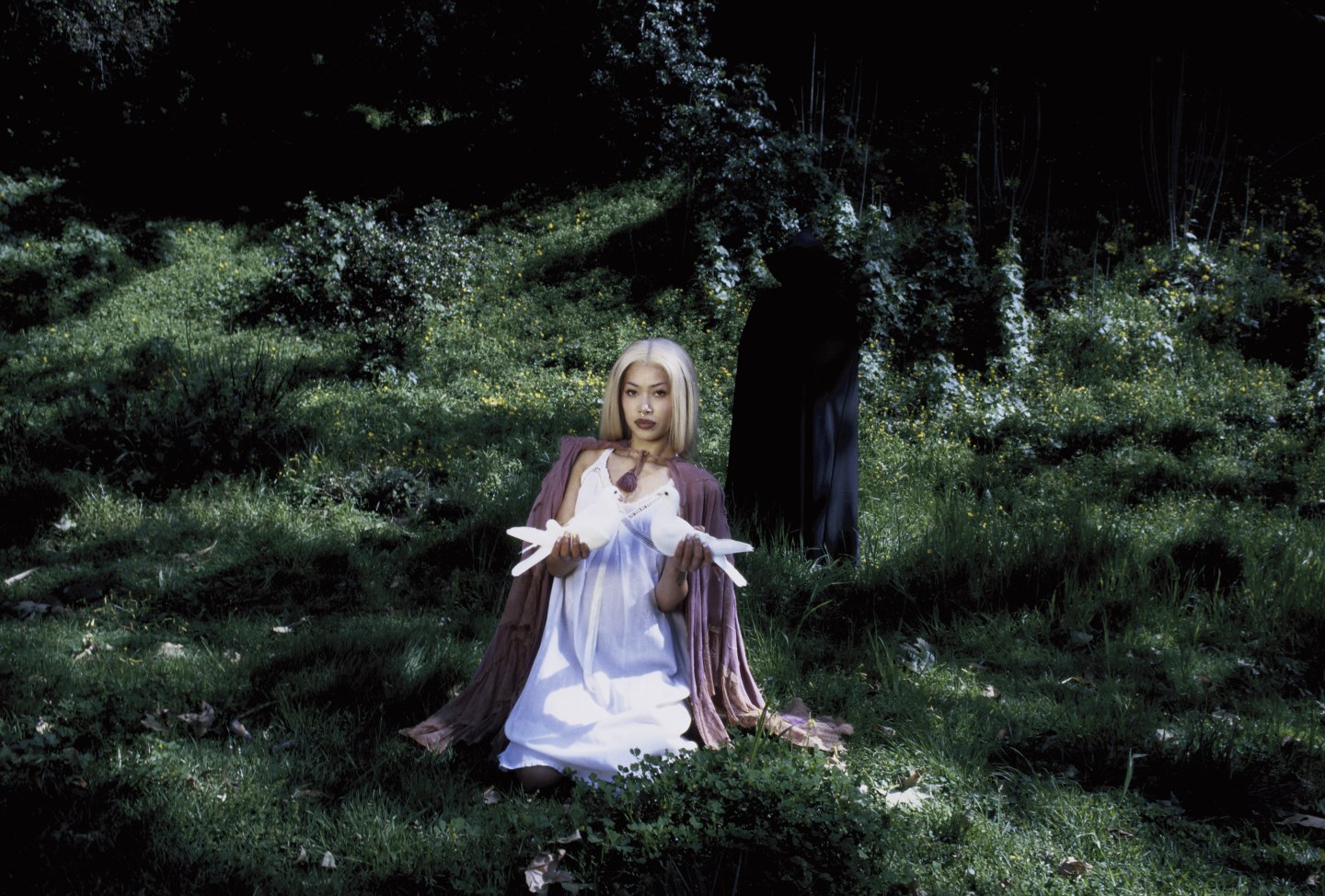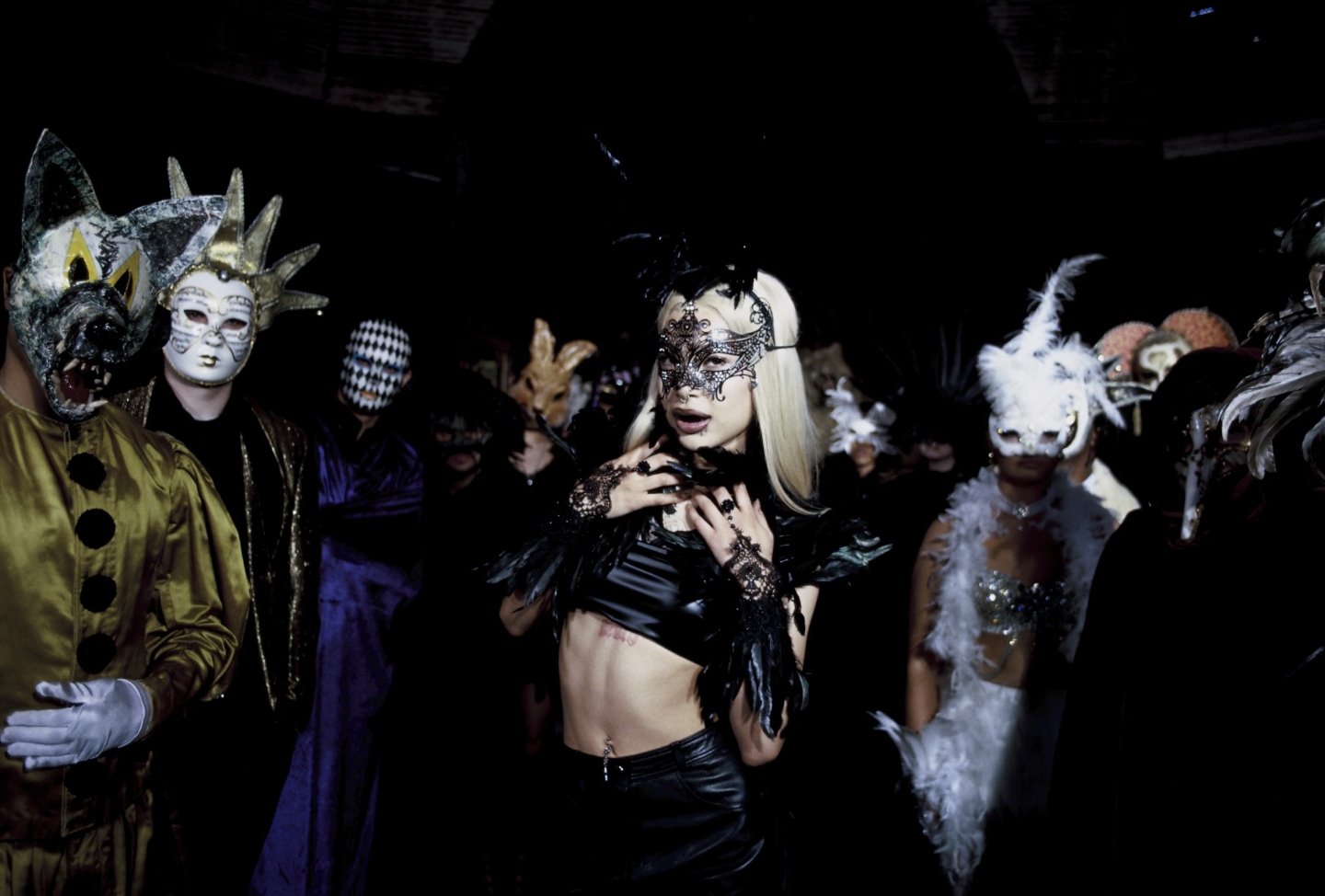Molly Santana’s trim fairy tales

Table of Contents
To create her new album Molly And Her Week Of Wonders, the Cali rapper wrestled with perfectionism, isolation, and making a new space for female rappers.

Molly Santana. Photo by Bailey Nolfe
Molly Santana is racing the clock. We’re 15 days away from the release of her sophomore album Molly And Her Week of Wonders, which means we’re dangerously close to the submission deadline, and nothing is quite finished.
“I’m literally editing this short film every day, and then focusing on the music,” Molly tells me on a May 15 video call. She’s in the courtyard of her LA apartment building, rocking a brat green henley long sleeve in the glare of the mid-afternoon sun. “Been trying to get everybody to send back their features — you know rappers, we’re late to everything.”
“It’s just been a nightmare,” she sighs. “But the best nightmare ever. Like, I don’t want to wake up yet.”
Part of the nightmare is self-inflicted: the 20-year-old rapper admits she’s a “last minute person,” indecisive until she has “no choice” but to commit to a release, and owns that she can be “super picky” with ideas and details. When I first hear a draft of Molly And Her Week of Wonders on May 8, none of the final features have come in, though she does play me an in-progress demo with Don Toliver, who she opened up for on tour with last year. By the time the album is submitted, complete with features from Che, Hardrock, and longtime collaborator Showjoe, songs will have progressed from “V4” and “V6” to “V12.3.6” as mixes and transitions are adjusted and readjusted.
Molly Santana first gained traction on social media as a fashion influencer in 2019 before starting to make music a couple years later. Now she’s a major label artist making bulldozing hip-hop that frequently pummels the listener into aural submission. Her songs can be more delicate (“What Did I Do Today”) or melodic (“Windows Up,” one of our top rap songs of 2024), but her tracks frequently feel like they would fit perfectly in a mix of eardrum-scraping bangers featuring contemporaries like OsamaSon and Nettspend.
Molly grew up in Fontana, California, about an hour outside of LA. She tells me she spent her early years studying artists “just as a fan” in her room, when she wasn’t hitting the skatepark or sketchy concerts with friends.
“I used to go to this one place in LA called The Smell and I would see crazy ass local punk bands,” she laughs. “I would just be in there like, 12 years old, getting my fucking piercings knocked. So that’s what really shaped who I am today.”
You can hear that brash energy on last April’s “Chain Swangin,” where Molly’s lower-register wail supercharges a Chief Keef-esque beat courtesy of Synthetic and Bass, or “Out My Body,” her marble-mouthed bars snaking through the thinnest space between blown-out 808s and clinking piano. Even in your earbuds, these are songs to rock out to, the sort that make you carelessly headbang in public, but they explode when she performs them live.
When I caught Molly at Rolling Loud Cali back in March, I was sandwiched between a quartet of heckling white male Zoomers and a pair of tweenage girls who whooped with glee as they documented Molly’s every move. The set was excellent, every sound and image carefully honed for maximum impact — in the tightly packed crowd, her piercing sirens and clobbering drums seemed to hit even harder than those in Playboi Carti’s headlining set a few hours later. But the moment felt like a microcosm for Molly Santana’s position in the modern hip-hop ecosystem as she fractures a new glass ceiling for women in rap.
“My whole North Star is to just influence women to bring back their power more and step into themselves more,” Molly explains. “And walk away from the super male dominant society and structure we have, especially in music.
“I don’t find anything wrong with music of girls having fun, summer music, like — I’m a fucking girl too,” she goes on. “But sometimes I feel like I look around and there’s not really anybody I look up to fully […] In the rap community specifically, there’s not really any female rappers concerned about building a legacy or telling a real story or explaining to girls why there aren’t any really big female rappers that don’t get thrown away after two [or] three years.”

Photo by Lily Lauria
Fastidious and frenetic, Molly And Her Week of Wonders is a world-beating album, a “pop” hip-hop record in the sense that Travis Scott and Playboi Carti make popular music. Molly tells me she was heavily inspired by Scott’s Birds in the Trap Sing Brian McKnight, and Week of Wonders is accordingly dense, deep, lush, synths extra glossy or translucent, kick drums rounded off just so. From the stuttering production flourishes on “BRB” to the groggy lurch of “Honest” to the children’s choir harmonies undergirding “Stupid Money,” MAHWOW carefully stitches ear candy over and around her flow. That’s especially true of “When I’m Gone,” where Molly’s vocals fade into the song’s coda like Charli XCX on “Track 10,” and “Handle It,” a vicious subwoofer thumper that mutates with every hook.
Molly Santana’s maximalist take on SoundCloud rap was already hyper-stylish, colliding soaring melodies and spitfire flows with “futuristic” instrumentals that stretch the sounds of her inspirations (Chief Keef and Lil Uzi Vert, of course; but also Reptilian Club Boyz, Black Kray, and Drain Gang) into more elaborate shapes. But Molly And Her Week of Wonders marks a serious step up in her songwriting and delivery, a cohesive record with surprising emotional weight. These are still hard-hitting rap songs, but whether contemplating the state of the music industry (“Not Regular”) or turning over the occasional romantic pang (“Globe”), Molly’s more lyrically open than she has been in the past.
There’s no point in me fake swag talking, because I’m where I wanted to be. I don’t have to dream and tell story tales anymore.
“When I was recording this album, we were in the middle of nowhere in Wyoming. The city was like, population of 200, one grocery store, so I feel like I had a lot of space to dig deep and really hear myself. This album, I’m older and grown more, and I have gotten to places that I’ve been wanting to be at for a long time.
“So there’s no point in me fake swag talking, because I’m where I wanted to be. I don’t have to dream and tell story tales anymore.”
Molly spent January in Wyoming with a crew of her go-to producers (“A house full of men,” she says drily), telling me it was almost like being in another country. “There were so many moose around us,” she laughs. “It was not much to do. I was really just cooking and then cooking figuratively.”
Aside from “BRB,” a late 2024 snippet that was entirely overhauled, every song on Week of Wonders was recorded during these wintertime sessions. “While I was in Wyoming, a lot of stuff was changing in my life, but I wasn’t there to see it,” she explains. “I was like, ‘What is going on? Why is everybody trying to distract me while I’m trying to record this damn album?’ I came here to get away from everybody and everything and there’s just so much lingering around.”
The album’s title and 16mm aesthetic of its trailers come from the 1970 Czechoslovak film Valerie and Her Week of Wonders, a fever dream of a Gothic movie wherein the titular heroine is beset by vampires, priests, men, and women all eager to take from her. Vivid, perverse, and seriously skeptical of authority, the film was recommended to Molly by video director Stan Smith more than a year ago, though the title only came into focus after leaving Wyoming.
“It didn’t really make sense to me until I really watched the movie three times. Now, it almost feels like a mirror of my life, but at first I didn’t understand,” Molly says. “I was like, ‘this name is so fucking long,’ and it sounds like I’m gonna be here and gone in a week, like I’m a one week wonder.”
Back in March, Molly told me she related to Valerie because, “I feel like everybody’s out to get me.” Molly And Her Week of Wonders isn’t exactly paranoid, but it’s certainly guarded. On a song like last year’s “Call Me What You Want,” Molly sounded satiated by the success she’d achieved to date; nowadays, she’s more focused on walking in her purpose than with the spoils of her labor.
“I’ve been doing music for almost four years now, and I haven’t lost the rose-colored glasses for it, I love it so much, but it’s way less like romantic than I thought it was when I was younger. Really good music comes from people’s pain and insecurities and from them feeling shut away from the world, or isolated and cast out.
“It’s a little bit depressing, but that is the beautiful thing about music. It’s so deep, but it’s also so not deep, too. Like sometimes you love a song and you don’t fuck with the artist. And it’s a whole ecosystem of different shit, and I thought it was so much more simple when I was younger. I was just like, I love these people. Hopefully one day I meet them. Now it’s like, sometimes I don’t want to meet my idols.”
“Sometimes you don’t want to meet the people that you really fuck with, because you don’t want to see the reality,” her voice picks up. “Music is like a dream, it’s like a fairy tale.”

If you liked the article, do not forget to share it with your friends. Follow us on Google News too, click on the star and choose us from your favorites.
If you want to read more Like this articles, you can visit our Social Media category.